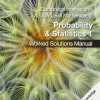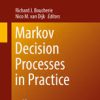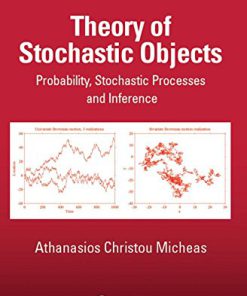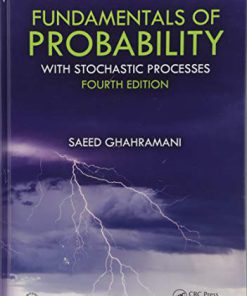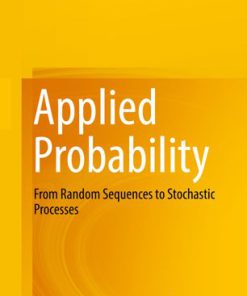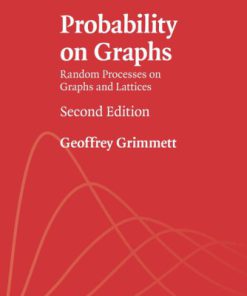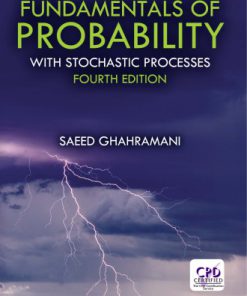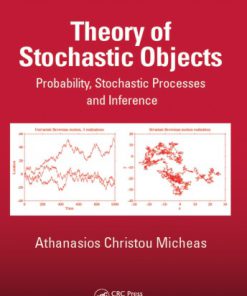Applied Probability and Stochastic Processes 2nd Edition by Frank Beichelt ISBN 1482257645 9781482257649
$50.00 Original price was: $50.00.$25.00Current price is: $25.00.
Applied Probability and Stochastic Processes 2nd Edition by Frank Beichelt – Ebook PDF Instant Download/Delivery: 1482257645, 978-1482257649
Full download Applied Probability and Stochastic Processes 2nd Edition after payment

Product details:
ISBN 10: 1482257645
ISBN 13: 978-1482257649
Author: Frank Beichelt
Applied Probability and Stochastic Processes, Second Edition presents a self-contained introduction to elementary probability theory and stochastic processes with a special emphasis on their applications in science, engineering, finance, computer science, and operations research. It covers the theoretical foundations for modeling time-dependent random phenomena in these areas and illustrates applications through the analysis of numerous practical examples. The author draws on his 50 years of experience in the field to give your students a better understanding of probability theory and stochastic processes and enable them to use stochastic modeling in their work.
New to the Second Edition
- Completely rewritten part on probability theory―now more than double in size
- New sections on time series analysis, random walks, branching processes, and spectral analysis of stationary stochastic processes
- Comprehensive numerical discussions of examples, which replace the more theoretically challenging sections
- Additional examples, exercises, and figures
Presenting the material in a student-friendly, application-oriented manner, this non-measure theoretic text only assumes a mathematical maturity that applied science students acquire during their undergraduate studies in mathematics. Many exercises allow students to assess their understanding of the topics. In addition, the book occasionally describes connections between probabilistic concepts and corresponding statistical approaches to facilitate comprehension. Some important proofs and challenging examples and exercises are also included for more theoretically interested readers.
Applied Probability and Stochastic Processes 2nd Table of contents:
PART I: PROBABILITY THEORY
1. RANDOM EVENTS AND THEIR PROBABILITIES
1.1 Random Experiments
1.2 Random Events
1.3 Probability
- 1.3.1 Classical Definition of Probability
- 1.3.2 Geometric Definition of Probability
- 1.3.3 Axiomatic Definition of Probability
- 1.3.4 Relative Frequency
1.4 Conditional Probability and Independence of Random Events - 1.4.1 Conditional Probability
- 1.4.2 Total Probability Rule and Bayes’ Theorem
- 1.4.3 Independent Random Events
1.5 Exercises
2. ONE-DIMENSIONAL RANDOM VARIABLES
2.1 Motivation and Terminology
2.2 Discrete Random Variables
- 2.2.1 Probability Distributions and Distribution Parameters
- 2.2.2 Important Discrete Probability Distributions
2.3 Continuous Random Variables - 2.3.1 Probability Distributions
- 2.3.2 Distribution Parameters
- 2.3.3 Important Continuous Probability Distributions
- 2.3.4 Nonparametric Classes of Probability Distributions
2.4 Mixtures of Random Variables
2.5 Generating Functions - 2.5.1 z-Transformation
- 2.5.2 Laplace Transformation
2.6 Exercises
3. MULTIDIMENSIONAL RANDOM VARIABLES
3.1 Two-Dimensional Random Variables
- 3.1.1 Discrete Components
- 3.1.2 Continuous Components
- 3.1.2.1 Probability Distribution
- 3.1.2.2 Conditional Probability Distribution
- 3.1.2.3 Bivariate Normal Distribution
- 3.1.2.4 Bivariate Exponential Distributions
- 3.1.3 Linear Regression and Correlation Analysis
3.2 n-Dimensional Random Variables
3.3 Exercises
4. FUNCTIONS OF RANDOM VARIABLES
4.1 Functions of One Random Variable
- 4.1.1 Probability Distribution
- 4.1.2 Random Numbers
4.2 Functions of Several Random Variables - 4.2.1 Introduction
- 4.2.2 Mean Value
- 4.2.3 Product of Two Random Variables
- 4.2.4 Ratio of Two Random Variables
- 4.2.5 Maximum of Random Variables
- 4.2.6 Minimum of Random Variables
4.3 Sums of Random Variables - 4.3.1 Sums of Discrete Random Variables
- 4.3.2 Sums of Continuous Random Variables
- 4.3.2.1 Sum of Two Random Variables
- 4.3.2.2 Sum of Random Variables
- 4.3.3 Sums of a Random Number of Random Variables
4.4 Exercises
5. INEQUALITIES AND LIMIT THEOREMS
5.1 Inequalities
- 5.1.1 Inequalities for Probabilities
- 5.1.2 Inequalities for Moments
5.2 Limit Theorems - 5.2.1 Convergence Criteria for Sequences of Random Variables
- 5.2.2 Laws of Large Numbers
- 5.2.2.1 Weak Laws of Large Numbers
- 5.2.2.2 Strong Laws of Large Numbers
- 5.2.3 Central Limit Theorem
- 5.2.4 Local Limit Theorems
5.3 Exercises
PART II: STOCHASTIC PROCESSES
6. BASICS OF STOCHASTIC PROCESSES
6.1 Motivation and Terminology
6.2 Characteristics and Examples
6.3 Classification of Stochastic Processes
6.4 Time Series in Discrete Time
- 6.4.1 Introduction
- 6.4.2 Smoothing of Time Series
- 6.4.3 Trend Estimation
- 6.4.4 Stationary Discrete-Time Stochastic Processes
6.5 Exercises
7. RANDOM POINT PROCESSES
7.1 Basic Concepts
7.2 Poisson Processes
- 7.2.1 Homogeneous Poisson Processes
- 7.2.1.1 Definition and Properties
- 7.2.1.2 Homogeneous Poisson Process and Uniform Distribution
- 7.2.2 Nonhomogeneous Poisson Processes
- 7.2.3 Mixed Poisson Processes
- 7.2.4 Superposition and Thinning of Poisson Processes
- 7.2.4.1 Superposition
- 7.2.4.2 Thinning
- 7.2.5 Compound Poisson Processes
- 7.2.6 Applications to Maintenance
- 7.2.7 Application to Risk Analysis
7.3 Renewal Processes - 7.3.1 Definitions and Examples
- 7.3.2 Renewal Function
- 7.3.2.1 Renewal Equations
- 7.3.2.2 Bounds on the Renewal Function
- 7.3.3 Asymptotic Behavior
- 7.3.4 Recurrence Times
- 7.3.5 Stationary Renewal Processes
- 7.3.6 Alternating Renewal Processes
- 7.3.7 Compound Renewal Processes
- 7.3.7.1 Definition and Properties
- 7.3.7.2 First Passage Time
7.4 Exercises
8. DISCRETE-TIME MARKOV CHAINS
8.1 Foundations and Examples
8.2 Classification of States
- 8.2.1 Closed Sets of States
- 8.2.2 Equivalence Classes
- 8.2.3 Periodicity
- 8.2.4 Recurrence and Transience
8.3 Limit Theorems and Stationary Distribution
8.4 Birth and Death Processes - 8.4.1 Introduction
- 8.4.2 General Random Walk with Two Absorbing Barriers
- 8.4.3 General Random Walk with One Absorbing Barrier
8.5 Discrete-Time Branching Processes - 8.5.1 Introduction
- 8.5.2 Generating Function and Distribution Parameters
- 8.5.3 Probability of Extinction and Examples
8.6 Exercises
9. CONTINUOUS-TIME MARKOV CHAINS
9.1 Basic Concepts and Examples
9.2 Transition Probabilities and Rates
9.3 Stationary State Probabilities
9.4 Sojourn Times in Process States
9.5 Construction of Markov Systems
9.6 Birth and Death Processes
- 9.6.1 Birth Processes
- 9.6.2 Death Processes
- 9.6.3 Birth and Death Processes
- 9.6.3.1 Time-Dependent State Probabilities
- 9.6.3.2 Stationary State Probabilities
- 9.6.3.3 Nonhomogeneous Birth and Death Processes
9.7 Applications to Queueing Models
- 9.7.1 Basic Concepts
- 9.7.2 Loss Systems
- 9.7.2.1 M/M/∞-System
- 9.7.2.2 M/M/s/0-System
- 9.7.2.3 Engset’s Loss System
- 9.7.3 Waiting Systems
- 9.7.3.1 M/M/s/∞-System
- 9.7.3.2 M/G/1/∞-System
- 9.7.3.3 G/M/1/∞-System
- 9.7.4 Waiting-Loss-Systems
- 9.7.4.1 M/M/s/m-System
- 9.7.4.2 M/M/s/∞-System with Impatient Customers
- 9.7.5 Special Single-Server Queueing Systems
- 9.7.5.1 System with Priorities
- 9.7.5.2 M/M/1/m-System with Unreliable Server
- 9.7.6 Networks of Queueing Systems
- 9.7.6.1 Introduction
- 9.7.6.2 Open Queueing Networks
- 9.7.6.3 Closed Queueing Networks
9.8 Semi-Markov Chains
9.9 Exercises
10. MARTINGALES
10.1 Discrete-Time Martingales
- 10.1.1 Definition and Examples
- 10.1.2 Doob-Type Martingales
- 10.1.3 Martingale Stopping Theorem and Applications
10.2 Continuous-Time Martingales
10.3 Exercises
11. BROWNIAN MOTION
11.1 Introduction
11.2 Properties of the Brownian Motion
11.3 Multidimensional and Conditional Distributions
11.4 First Passage Times
11.5 Transformations of the Brownian Motion
- 11.5.1 Identical Transformations
- 11.5.2 Reflected Brownian Motion
- 11.5.3 Geometric Brownian Motion
- 11.5.4 Ornstein-Uhlenbeck Process
- 11.5.5 Brownian Motion with Drift
- 11.5.5.1 Definitions and First Passage Times
- 11.5.5.2 Application to Option Pricing
- 11.5.5.3 Application to Maintenance
- 11.5.6 Integrated Brownian Motion
11.6 Exercises
12. SPECTRAL ANALYSIS OF STATIONARY PROCESSES
12.1 Foundations
12.2 Processes with Discrete Spectrum
12.3 Processes with Continuous Spectrum
- 12.3.1 Spectral Representation of the Covariance Function
- 12.3.2 White Noise
12.4 Exercises
People also search for Applied Probability and Stochastic Processes 2nd:
applied probability and stochastic processes solution manual pdf
stochastic probability theory
what is applied probability
methods of mathematical finance stochastic modelling and applied probability
difference between probabilistic and stochastic
Tags:
Frank Beichelt,Applied,Probability,Stochastic,Processes 2nd
You may also like…
Mathematics
Theory of stochastic objects probability stochastic processes and inference 1st Edition Micheas
Science (General)
Applied Stochastic Modelling, Second Edition Byron J T Morgan
Mathematics - Probability
Physics - Theoretical Physics
Mathematics - Probability
Science (General)
Theory of stochastic objects: probability, stochastic processes, and inference First Edition Micheas


